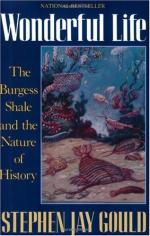
|
| Name: _________________________ | Period: ___________________ |
This test consists of 15 multiple choice questions and 5 short answer questions.
Multiple Choice Questions
1. What happened from 1971 through 1978 that changed everything?
(a) Gradually.
(b) Years of scientific debate.
(c) Two months of pondering.
(d) Sporadic leaps in clarity.
2. What is the name of the small ribbon-shaped creation that is the first member known of the 'chordate' phylum?
(a) Nikaia.
(b) Oakaia.
(c) Mikaia.
(d) Pikaia.
3. What is the problem with the Burgess Shale in relation to many of the similarities and distinctions?
(a) Few are unknown and there are so many different classifications.
(b) Only two are known and there are no classifications to put them in.
(c) The classification system needs a complete overview.
(d) Many are unknown and this makes classification difficult.
4. What was Whittington the world expert on at the time?
(a) Yohoias.
(b) Paleontologists.
(c) Trilobites.
(d) Fossils.
5. What did Act 3 explain?
(a) Idotixis is not an arthropod.
(b) Opabinia is not an arthropod.
(c) Idotixis is an arthropod.
(d) Opabinia is an arthropod.
6. How many general Burgess revisions did we acquire?
(a) Six.
(b) Three.
(c) Five.
(d) One.
7. What adjective describes how Whittington first felt when working on Naraoia?
(a) Excited.
(b) Worried.
(c) Anxious.
(d) Frustrated.
8. What five new species did Morris find?
(a) Hallucigenia, Odontogriphus, Dinomischus, Maskinal, and Frutogenia.
(b) Fologenia, Maskinal, Odontogriphus, Dinomischus, and Hallucigenia.
(c) Nectocaris, Odontogriphus, Dinomischus, Amiskwia, and Hallucigenia.
(d) Hallucigenia, Odontogriphus, Dinomischus, Amiskwia, and Malaria.
9. What is the classification of animal species specifically warned to not be made on alone?
(a) Time and timing of the discovery.
(b) The basis of similarities and differences.
(c) Appearance, function and historical context.
(d) Five or more paleontologists.
10. What did Gould say the next generation must do with the Burgess Shale?
(a) Work on it with old techniques and forms of analysis.
(b) Work on it with new techniques and forms of analysis.
(c) Work on it with new techniques and forms of paradigms.
(d) Fix it with revised techniques and forms of analysis.
11. Where did Collins find another dig site?
(a) In Alaska.
(b) Five miles north of the original quarry.
(c) On the other side of the mountains.
(d) Five miles south of the original quarry.
12. What is the third stage of the fauna?
(a) The Cambrian explosion.
(b) The introduction of the egg.
(c) The introduction of the spine.
(d) The Pre-Cambrian explosion.
13. What did Naraoia lead Whittington to do?
(a) Dismiss Naraoia as a fluke.
(b) Begin a new class called Trilobitoidea.
(c) Dismiss the entire class Trilobitoidea as artificial.
(d) Combine two classes to create Trilobitoidea.
14. What type of example is Aysehaia?
(a) A godsend example.
(b) A omnipresent example.
(c) A lesser example.
(d) A further example.
15. How was Whittington inclined to see Opabinia?
(a) As crazy.
(b) As insane.
(c) As a lunatic.
(d) As an oddball.
Short Answer Questions
1. What large crab with an enormous number of spines did Collins publish a monograph on in 1985?
2. What is Canadaspis?
3. How many major contingencies along the path toward human development does Gould guide the reader through?
4. What do bats superficially resemble?
5. When did many species of hominid exist?
|
This section contains 486 words (approx. 2 pages at 300 words per page) |

|




